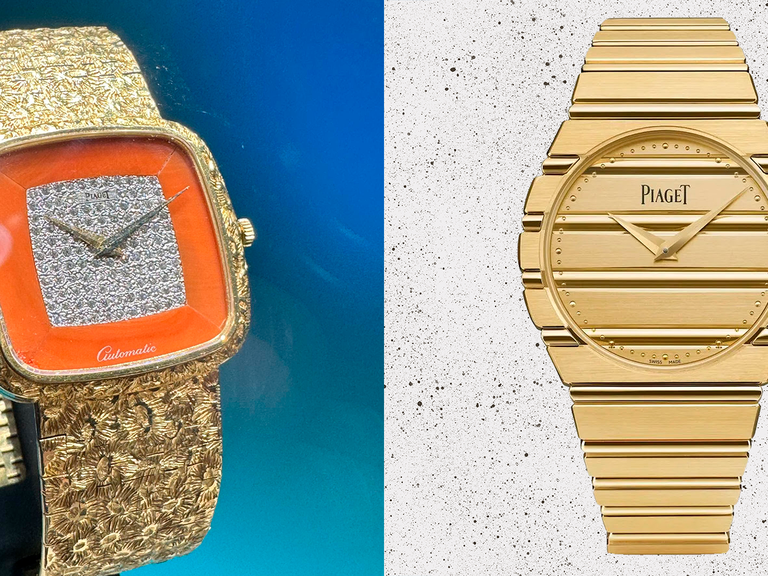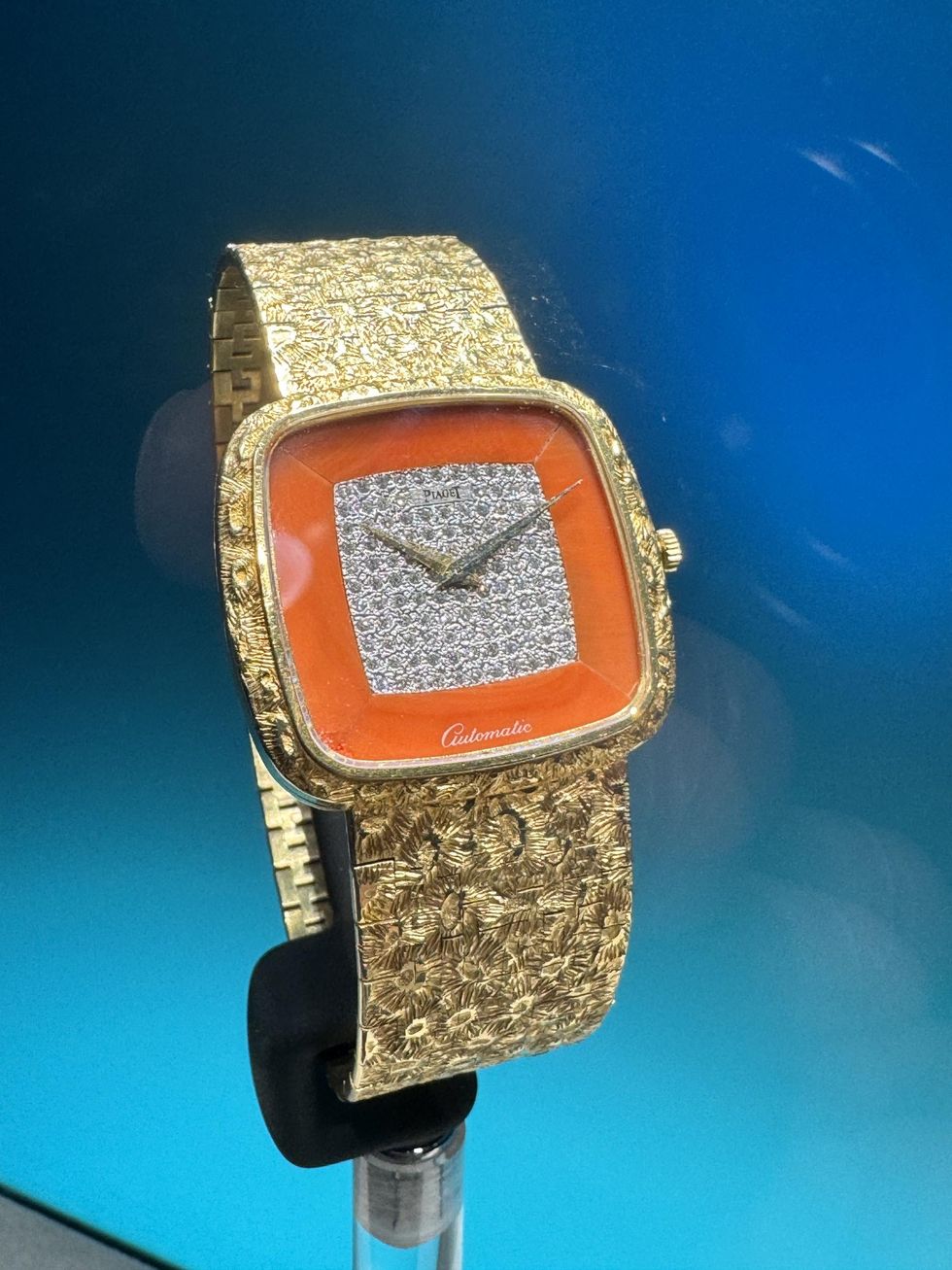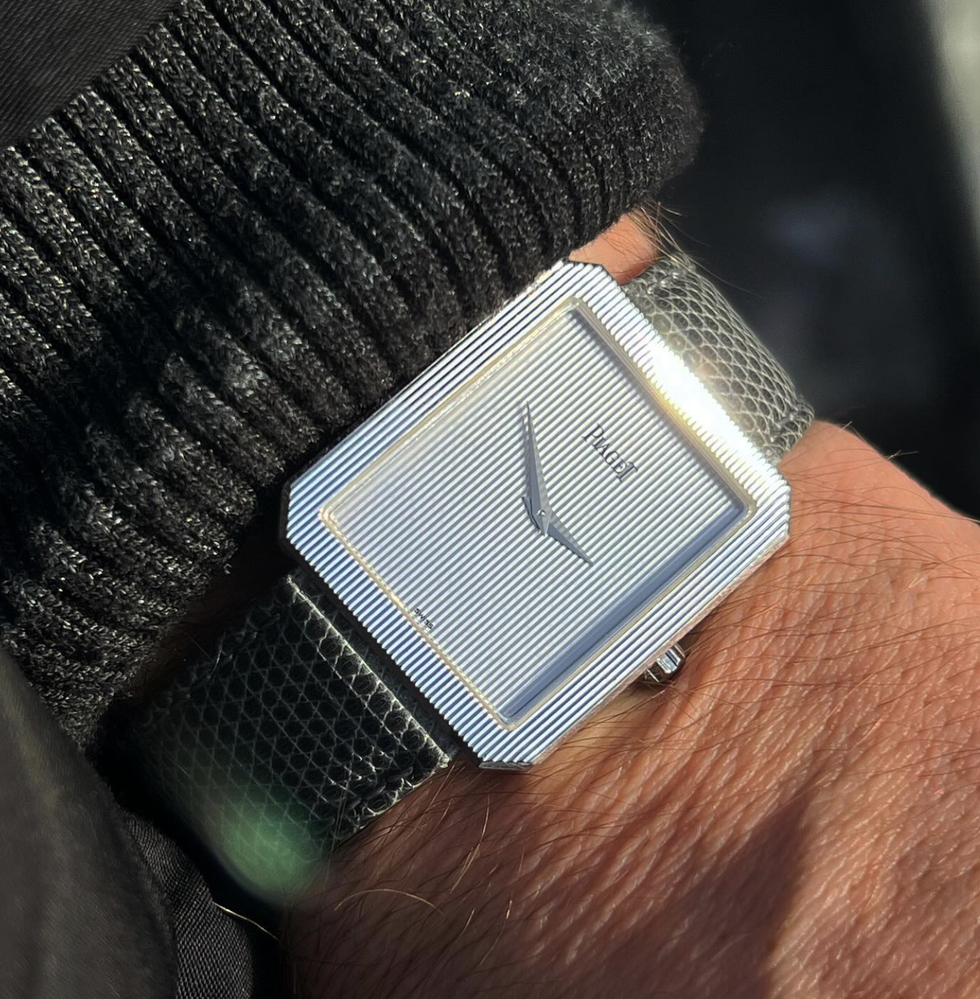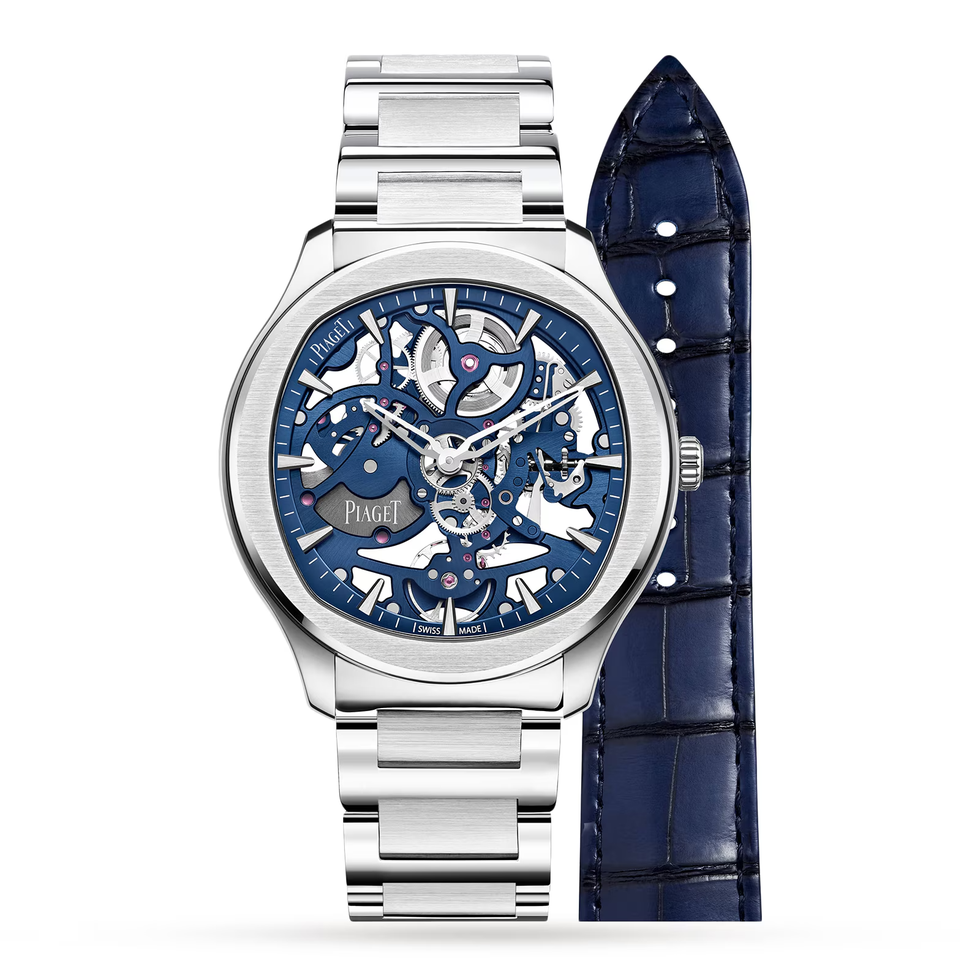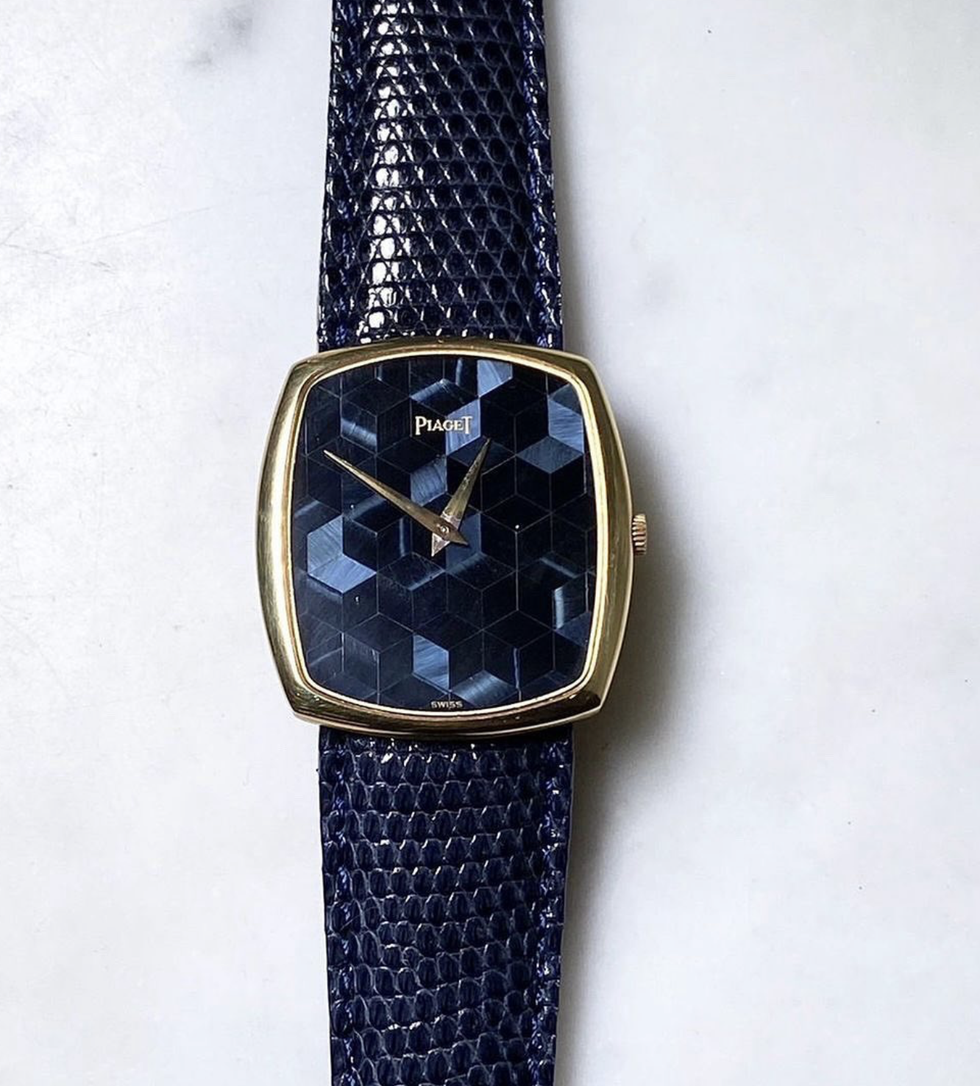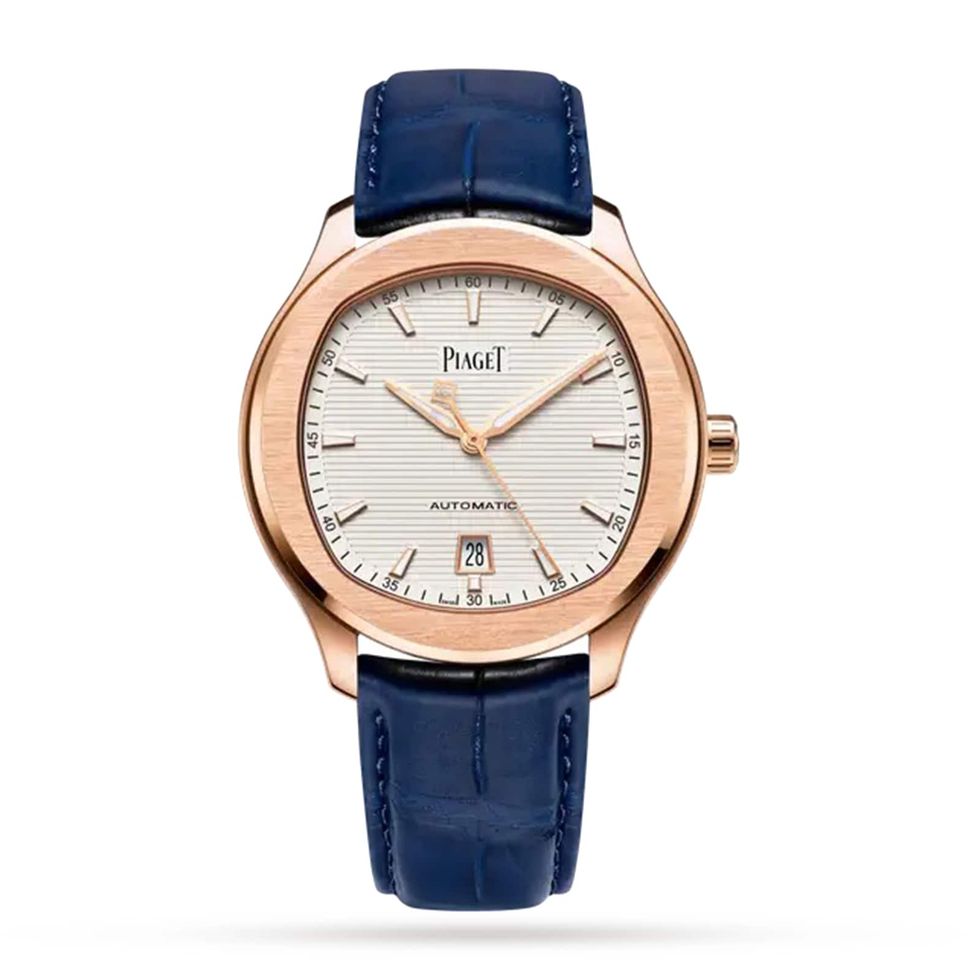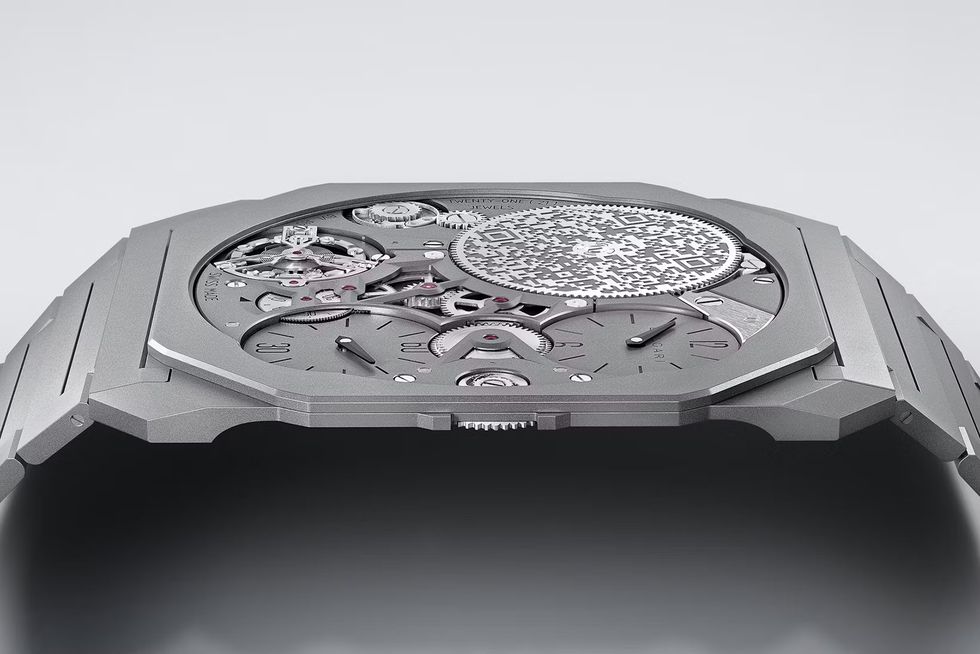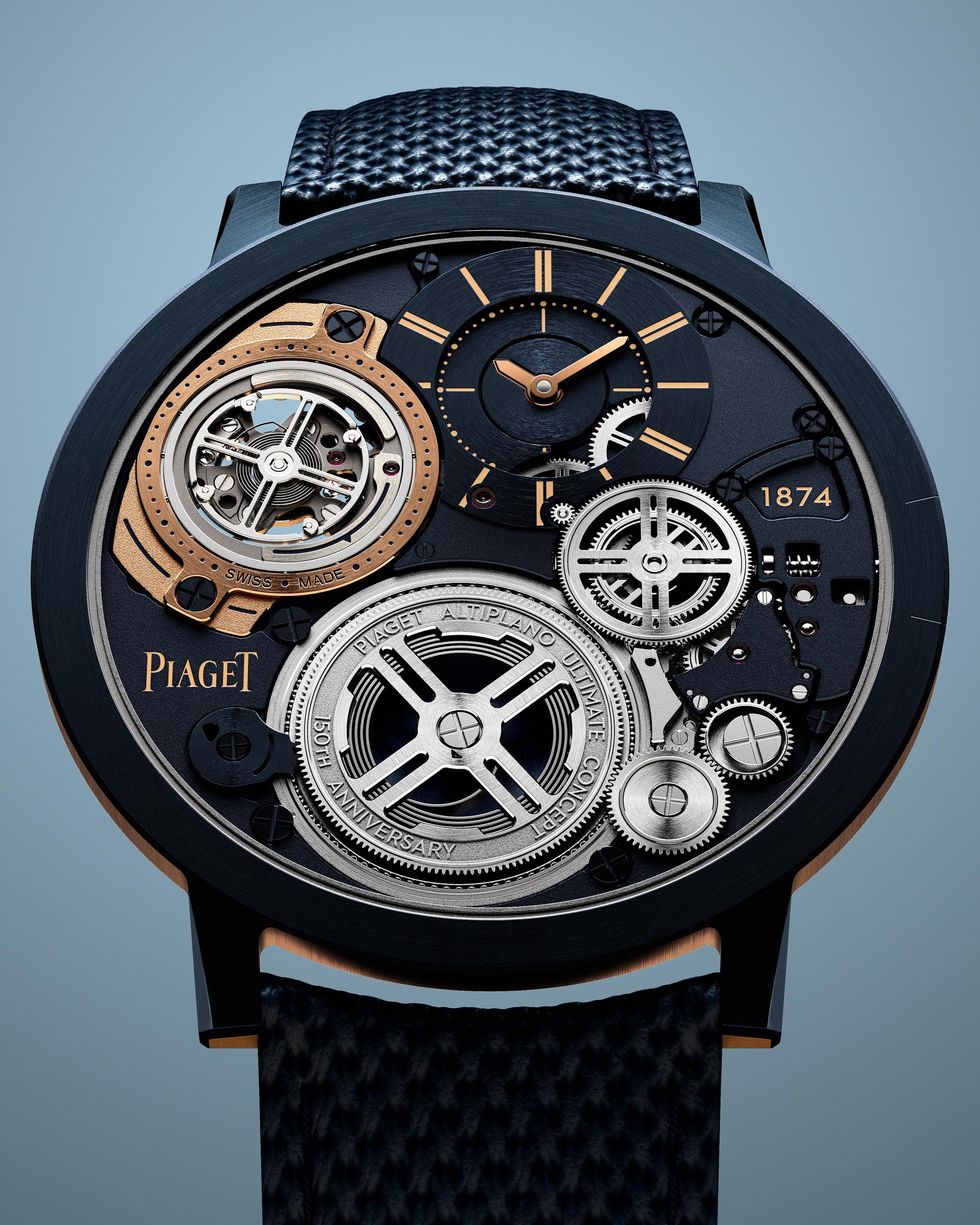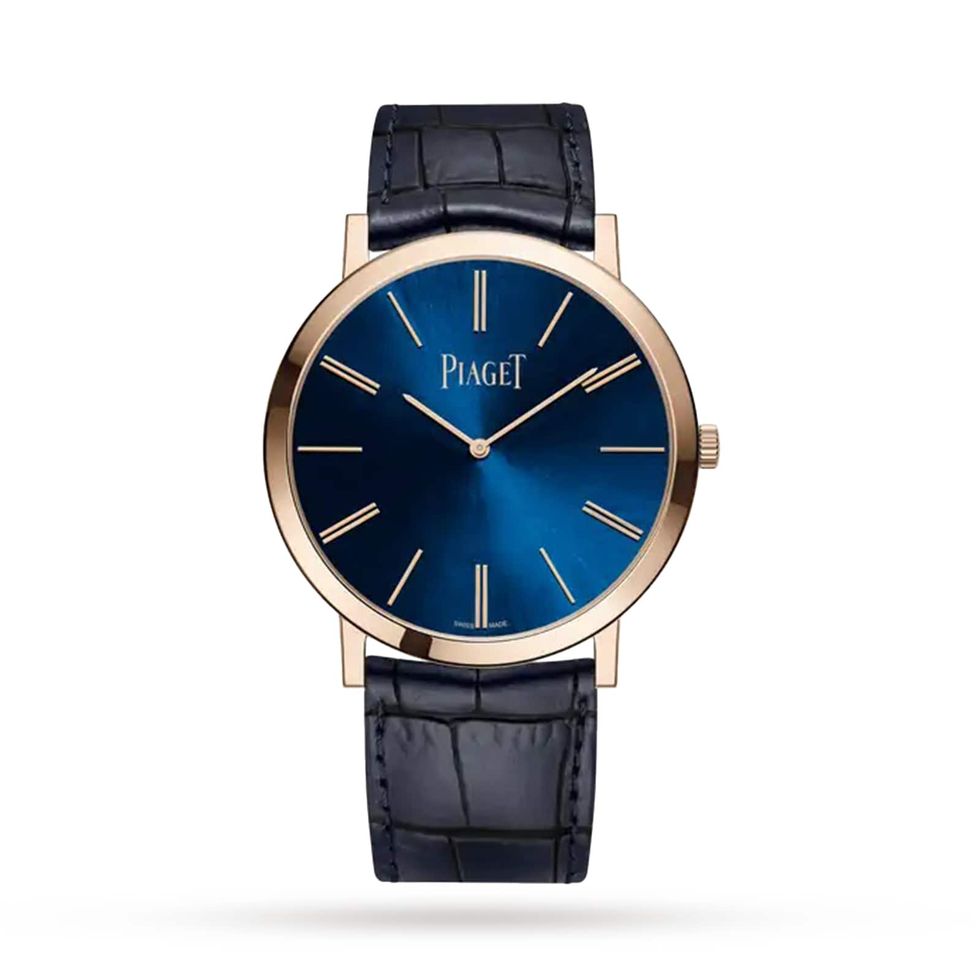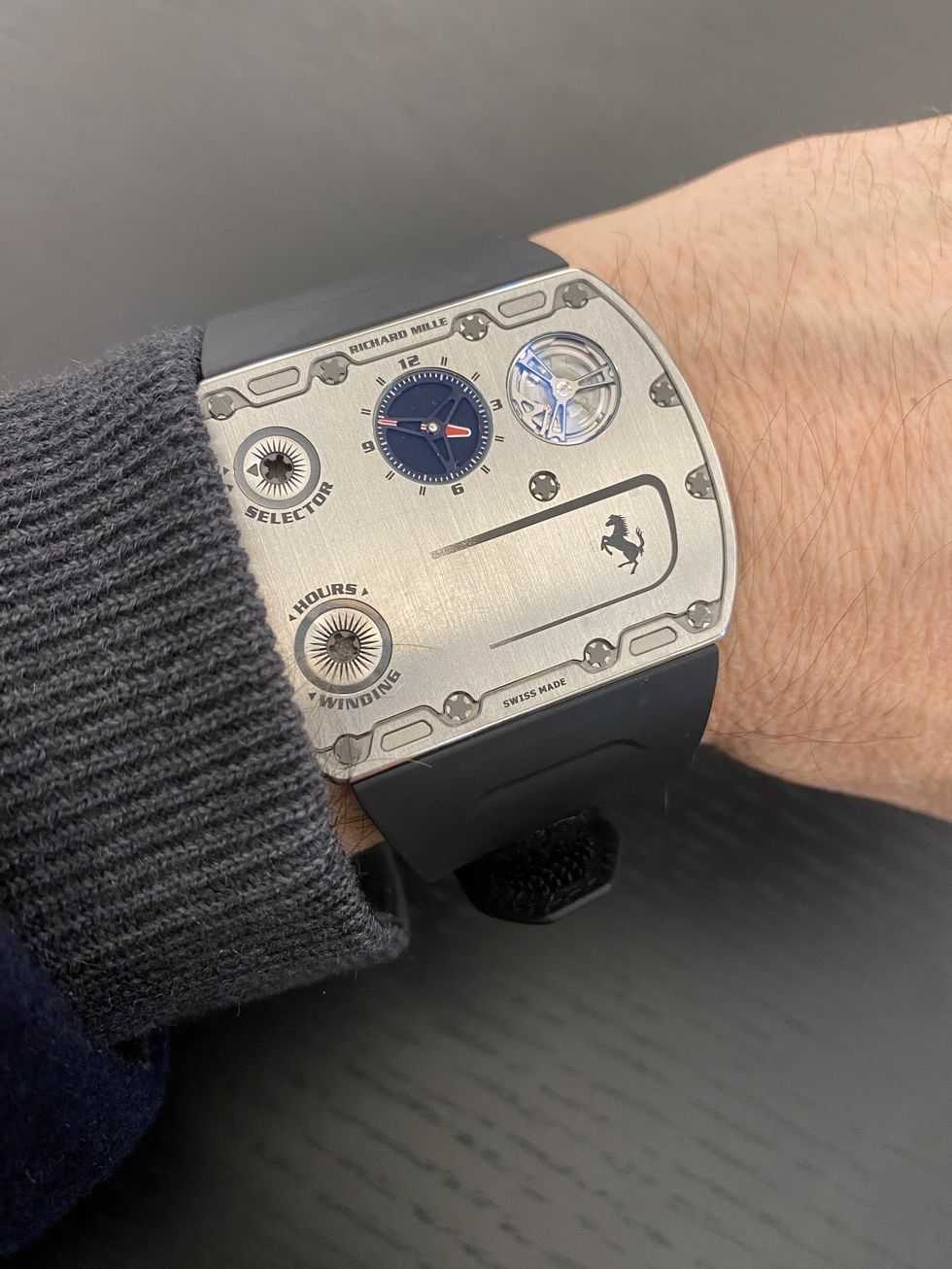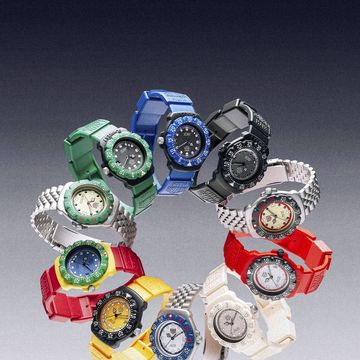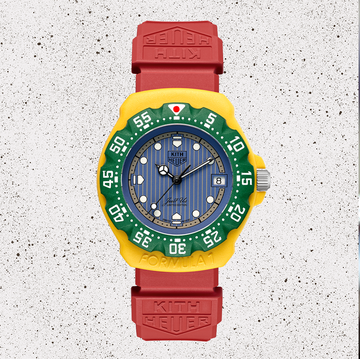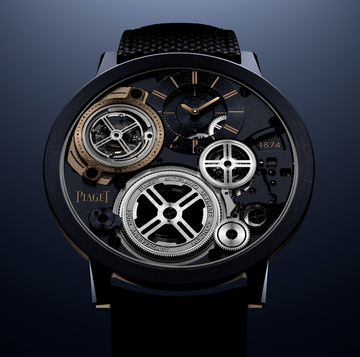This story is taken from Esquire's About Time newsletter, style director Johnny Davis’s straight-talking take on the wonderful world of watches. Sign up here.
As soon as I landed in Geneva last week for the 2024 Watches And Wonders trade fair, I hotfooted it straight over to Sotheby’s.
The auction house was staging a watch sale that really was unlike anything else any other similar institution had ever put on before (its representatives seemed both simultaneously proud of this, and a bit nervous it might have gone too far).
The show was called Rough Diamonds.
It was presented – in its logo, and in the t-shirts and posters it was selling – in the spirit of a 1990s dance band knowingly referencing the 1970s – Daft Punk, say, or Phoenix.
It was a collaboration between Sotheby’s and the youthful French watch media provocateurs Heist-Out, memorably described by one newspaper as ‘le punk plus de l’horologie’.
The idea, lest it not already be obvious, was to kick the stuffy auction world up the derriére and see if they couldn’t present a watch sale in a slightly more exciting way.
(You can read About Time's earlier interview with all the parties concerned in staging the sale here.)
But it wasn’t just the graphics – the exhibition preceding the sale was held underground, in a wine cellar. Then there were the exhibits themselves – sparkling watches-cum-jewellery pieces from the 1960s, 1970s and 1980s.
They included a yellow gold and diamond-set Vacheron Constantin bracelet watch with a trapezoidal dial and a design inspired by the sun’s rays. A dinky Audemars Piguet in the shape of a little car, made from emeralds and diamonds, something the Sultan of Brunei had commissioned for his children.
There was also a fabulously sparkly coral-dial Piaget number, diamond-set and crafted in yellow gold under the expertise of renowned designer Jean-Claude Gueit. Its diamonds were said to be reminiscent of the starry sky over St. Barts. Its textured gold bracelet was ‘emblematic of the era of the 1970s’ in exactly the way you'd imagine a textured gold bracelet ‘emblematic of the era of the 1970s’ would be.
The whole experience was fantastic, and it was easy to imagine it being something that would be referenced for years to come – a Ground Zero for the time auction houses learned to loosen their ties and pour themselves a White Russian or two.
On Friday, Sotheby's announced the Rough Diamond's sale's record results: all 24 lots had sold in under an hour, achieving almost double the event's high estimate, and bringing in more than CHF 1.15m (£1.03m).
(To underline its novelty, as well as to completely miss the point, some media immediately reported this as 'the auction house's first gender-free watch auction' .)
But the yellow gold, coral and diamond Piaget on display was emblematic of something else, too.
By general agreement within the watch cognoscenti vintage Piaget is having A Moment.
Who can say why, exactly?
For one thing fashion’s fickle wheel has spun away from boring classic steel sports watches that have dominated the market for the last decade or so.
The man who runs eBay’s watches and luxury division told me at Watches And Wonders that the most-searched-for dial colour for men on the site right now is pink.
Pink!
Second, the watch community has simply decided that 1960s-1980s Piaget is where it is at right now. And so it has come to pass.
Piaget put out its first watches with dials made of precious stones – lapis lazuli, turquoise, onyx, tiger’s eye – in 1964. Soon after, it launched its first ‘cuff watch’, a showy-offy wrist accessory that also happened to tell the time. Cushion-shaped cases, integrated bracelets and applied-hour markers with thick geometric angles were calling cards, too. Andy Warhol, Miles Davis and Elvis Presley were all Piaget fans.
Today on Instagram you can take your pick from popular accounts bigging up Piaget’s blingiest era – Protocole watches with glossy black dials and artfully ornate 18k yellow-gold cases over at @craftedandtailored. The 'Beta 21' with its oddly stepped vertical case on @morillo55. Lapis lazuli dials at @the_keystone.
Writing on Wind Vintage last year, watch specialist Charlie Dunne nailed vintage Piaget's appeal better than anyone. 'These watches are audacious and loud,' he said. 'Yet they don't give off a distasteful impression... when you see someone confidently rocking a vintage Piaget, it's quite apparent that they have a different perspective and appreciation for timepieces than most.'
In 1979 Piaget launched a jet-set all-gold number that was unambiguously not for the hoi polloi, the Piaget Polo. While other brands marketed timepieces that were tough enough to be worn whilst playing polo, Piaget’s Polo was intended for people who preferred to stand around watching the polo.
“The entire Polo philosophy can be summed up in one sentence,” chairman Yves G Piaget said at the time. “It’s a watch bracelet rather than a mere wristwatch.”
“The concept was: ‘The most expensive watch in the world’,” Jean-Bernard Forot, Piaget’s current head of patrimony told me recently.
Piaget relaunched a replica Polo – the Polo 79 – this February.
Made of solid gold it came with an appropriately solid price: £69,000. It caused quite a stir. Publications variously described it is ‘the comeback of the year’, ‘the return of an icon’ and ‘the hottest release of 2024’.
This year marks Piaget's 150th anniversary and you could see the stars in that starry sky over St. Barts aligning.
“Piaget is a jeweller, and as they celebrate their 150th they must pay homage to the achieve,” Brynn Wallner, founder of watch platform Dimepiece and the millennial New Yorker described as ‘the woman behind the world’s hottest Instagram account’, told me.
“And the 1970s are back in fashion. We’ve seen all the Gucci stuff, all the old-school look coming back and I think that the jewellery-house watchmakers tend to be a little more on-trend with what’s going on in fashion. And [Piaget] has taken notice of this. We’ve seen the hype on social media. And with social media bringing more opinions to the forefront, I think we’re seeing a lot of brands responding more to trends. It's exciting."
“When Timothée Chalamet started wearing that tiny little Cartier Tank Panthère [a more typically feminine dress watch, and a style worn by the actor in 2023], it started to feel like it was following through to Piaget,” says Christy Davis, founder of UK-based preowned watch specialists Subdial.
“Their stone dials feel like the next trend. They’re a super-interesting brand because they were always unashamedly, unapologetically for the elite. It tended to be royalty, celebrities and a lot of South American customers. They really spoke of 1980s luxury and were so flashy that they fell out of fashion – but that fashion is back.”
“It’s a backlash against the high-tech, sports watch thing,” one senior watches and jewellery PR believes. “People are looking for more authentic stories and less commercial-slash-designed-by-committee models. Something that isn’t available in every high street and shopping mall. Then combine that with people like Tyler, the Creator and Timothée Chalamet in Cartier, and Michael B Jordan wearing vintage Polo, too.
“Plus, they bring a spirit of joy and exuberance that is needed when the world is having such a shit time. Watches like that can bring you joy.”
So, one might have expected the product development team at Piaget Towers to have dusted off 12-months’ worth of TV-shaped stone dial watches, lapis lazuli rings and gold cuffs from its archives and booked the rest of 2024 off.
Expect Piaget is also expert in another watchmaking niche that may at first seem like the polar opposite of all this brash and bold retro stuff.
That niche is utterly modern, ultra-thin watchmaking.
Six years ago, Piaget came out with its Altiplano Ultimate Concept, a watch that measured a mere 2mm thick – the same as two sheets of A4 – something that necessitated a radical reengineering of the entire product and was achieved by fusing the case, the bezel and the movement’s main plate into one single component. (It also required five separate patents.)
But Piaget had competition.
The Swiss-Italian watchmaker Bulgari has also made a name for itself in perusing insanely skinny mechanical watches, and in March 2022 released the Octo Finissimo Ultra, a watch that measured just 1.8mm – securing its eighth world-record in the speciality of thin watches.
And then, just four months after that, in July 2022, Richard Mille, the French watchmaker known for its singular pursuit of high-performance materials and avant-garde designs, partnered with Ferrari to slip out the RM UP-01 Ferrari.
This one clocked in at 1.75mm, shaving 0.05mm off the world record – and making it the thinnest mechanical watch ever made.
This story is taken from Esquire's About Time newsletter, style director Johnny Davis’s straight-talking take on the wonderful world of watches. Sign up here.
All this microscopic engineering takes years of R&D and does not come cheap – the Piaget Altiplano Ultimate Concept cost around £350,000, the Bulgari Octo Finissimo Ultra would set you back something in the region of £440,000 while the Richard Mille UP-01 Ferrari retails for £1.4m – or about £1,000 per micron. (At that price, it should come with its own Ferrari – ha ha.)
The other thing is, these are not the most practical of watches.
By removing such bothersome elements as the crown and the crystal, the Richard Mille watch looks a piece of machined metal that’s been steamrollered and squashed flat. It wears on the wrist like something someone might have used to contact the Liberator in Blakes 7.
All three watches require a tiny Allen-key like device – or ‘winding tool’ – to make them run. Probably best to find a safe place to keep that.
Not to be outdone in this (small) dick-swinging competition, on Monday Bulgari reclaimed its paper-thin crown by announcing the Octo Finissimo Ultra COSC, with a thickness of just 1.7mm. Which, for anyone still keeping up, took another 0.05mm away from Richard Mille – roughly the breadth of a human hair.
It was hard not to see Bulgari’s timing as a spoiler for our friends over at Piaget, whose big reveal for Watches And Wonders this year – just 24-hours later – was the announcement of the Altipino Ultimate Concept Tourbillon. At 2mm it equalled its 2018 best.
It could, however, claim one record its rivals could not. The Altipino Ultimate Concept Tourbillon was the world’s thinnest watch to include a tourbillon, the constantly spinning ball-shaped complication beloved of high-end horology that rotates the inner mechanics of watch, apparently to counteract any meddlesome effects of gravity, but also because tourbillons tend to look cool.
To fit a tourbillon inside a watch and keep everything at 2mm was no easy feat – the new Altiplano may look somewhat similar to previous versions, but it required 90 percent of its components to be redesigned.
Piaget, then, arrives at its 150th year with joint reasons to celebrate.
Cutting-edge 21st Century ultra-thin watchmaking. And so-hot-right-now 20th Century jewellery-adjacent retro pieces that have swung back into vogue.
Perhaps these seem contradictory?
Au contraire, Piaget’s Jean-Bernard Forot told me when we spoke over Teams before the Watches And Wonders fair.
Both ideas are part and parcel of his brand's DNA.
“The fact there this is an alignment with our 150th anniversary [for these two elements] shows that we are a maison which is very focused on distinction,” he said.
“If you can afford a Polo 79 or you can afford an Ultimate Tourbillion, then you are not only buying a product, but you are buying know-how and you are buying a story. That is key for us. For the way we think about our clientele. And, then, if the community of what I would call the ‘watchinistas’, the people who are really fans, who are really digging behind the scenes and are discovering models that were designed in the past for us, it’s great – because it is elevating the [whole] momentum of Piaget. It means Piaget is in the ‘now’. So, it’s important for us to have both.”
Anyway, Forot says, the high-tech Altiplano and the pieces from 50 years ago have more in common than it might appear. Piaget was the original ultra-thin brand – specialising in the art of miniaturisation from the early 20th century.
Like a reverse TARDIS its watches might have been big on the outside, but inside it was a different story. In 1957 it came up with a hand-wound movement that was just 2mm thick. It followed that up with a 2.3mm self-winding mechanical movement three years later. The aforementioned cushion-shaped Beta 21 was developed from a consortium of Swiss brands that in 1966 created revolutionary quartz technology.
As Charlie Dunne writes, Piaget was among few manufacturers to have earned a reputation for its specialisation in coin watches – 'extremely rare and special creations that required the dissection of two coins, a master case maker to carve an area for the movement and to create a hinged component that lays perfectly within the two sides'.
“The philosophy of [the Piaget family] was always to ‘do better than is necessary’,” Forot says. “Piaget has always had this balance between aesthetics and technicality. We have never stopped trying and innovate, to reduce the thickness of every component. In our [old] advertising campaigns, it is [part of our DNA], almost like the advertising of Chanel of Hérmes. It’s continuity.”
(“I feel like Piaget is accustomed to playing in these different spaces,” says Brynn Wallner. “They have bought up a client base where one likes the more old-school stuff and the other one likes the more modern. But when I see that ultra-thin [Altiplano] I do see a very modern watch but I also see their expertise as a jeweller shining through because of the construction of it, and how elegant it is. It makes sense when you really consider it.”)
Of the upstarts over at Bulagri and Richard Millie, Forot is generous.
“There are two ways of thinking about the competition,” he says. “One is that they are challenging us. But they are also showing the strong importance of ultra-thin movements. And that’s a speciality for which Piaget has always remained true – for more than 67 years [when it made its first ultra-thin movement], or 150 years if we start from the escapement [when it developed its very first watch]. So, it brings attention to us, and hopefully captures a larger audience."
“Bulgari and Richard Mille are also able to create extraordinary objects. Of course you have competition in business, but you also have innovation and a spirit of confrere – community. So we are very interested to see what the others are doing.”
It's perhaps also worth noting that Paiget’s Altiplano does actually look like a watch – all the dial parts are pleasingly symmetrical – which is not the case over at Richard Mille.
“It’s an experiment, almost encapsulating a credit card,” Forot said of the Ferrari collab. “Maybe more like an object than a watch.”
He is, of course, only too aware of the current frothy hype around Piaget’s 1960s, 1970s and 1980s jewellery-watches.
“We are pretty proud to see that,” he says. “There is a big community of fans, reinforcing the Piaget style.”
That point in Piaget’s history was a time, he says, where anything went.
“The designers were focusing more on style, because the clientele of Piaget was jet-set, the new aristocracy. People were finally able to take advantage of the aristocratic style, without constraints. There was a new way of dressing and enjoying life, with less rules. It was very important to 'show your wealth on yourself’. With the Polo, Piaget was really able to capture that.”
The anniversary year is really only just getting started – and more Polo 79-style rereleases must surely be on the cards.
“Of course,” Forot says. “You have to stay turned. It’s like a Netflix series! There will be more surprises than the Polo 79 to be discovered.
“And whatever we do, we will always continue in the true Piaget style and identity."
We'd expect nothing less.
This story is taken from Esquire's About Time newsletter, style director Johnny Davis’s straight-talking take on the wonderful world of watches. Sign up here.
